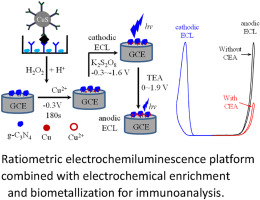Electrochimica Acta ( IF 5.5 ) Pub Date : 2020-01-17 , DOI: 10.1016/j.electacta.2020.135725 Xuemei Wang , Qiao Zhang , Qi Kang , Guizheng Zou , Dazhong Shen

|
Herein, we report a high sensitive ratiometric electrochemiluminescence (ECL) method for carcinoembryonic antigen (CEA) determination. Porous g-C3N4 nanosheets were immobilized on the surface of conductive polymer film doped with carbon nanotubes on glassy carbon electrode and used as ECL luminophore. Signal amplification was achieved by using CuS nanoparticles conjugated second antibody. After the immune recognition, the tag of CuS nanoparticles was dissolved and Cu(II) was electrochemically reduced to Cu on the surface of modified electrode at the - 0.3 V (vs. Ag/AgCl), enhancing greatly the sensitivity. The cathodic ECL of g-C3N4 generated with K2S2O8 as the co-reactant was firstly measured and used as the reference signal in the ratiometric measurement. Afterwards, the anodic ECL of g-C3N4 was measured as the sensing signal with triethanolamine as the co-reactant. During the anodic ECL process, the pre-deposited Cu was stripped to Cu(II), which can quench the ECL signal with higher efficiency due to the short distance of g-C3N4 and Cu(II) within the Helmholtz layer on the electrode surface. In this ratiometric method, the amount of Cu(II) was determined to quantify the concentration of CEA in the range of 1 fg mL−1 to 0.1 ng mL−1, with the limit of detection of 0.3 fg mL−1, which is lower than that of 3 fg mL−1 in signal-on ECL immunesensor using g-C3N4 as the tag. The combination of biometallization and anodic stripping voltammetry with ratiometric ECL can enhance significantly the sensitivity and reliability in immunosensors.
中文翻译:

结合阳极溶出伏安法的高灵敏单荧光体比率电化学电化学发光免疫传感器
本文中,我们报告了一种用于癌胚抗原(CEA)测定的高灵敏度比例电化学发光(ECL)方法。将多孔gC 3 N 4纳米片固定在玻璃碳电极上掺杂有碳纳米管的导电聚合物膜的表面上,并用作ECL发光体。通过使用CuS纳米颗粒偶联的第二抗体实现信号放大。免疫识别后,将CuS纳米颗粒的标签溶解,并且在修饰电极的表面以-0.3 V(相对于Ag / AgCl)将Cu(II)电化学还原为Cu,从而大大提高了灵敏度。用K 2 S 2 O 8生成的gC 3 N 4的阴极ECL首先测量作为共反应物的α-烯烃,并将其用作比率测量中的参考信号。然后,以三乙醇胺作为共反应物,测量gC 3 N 4的阳极ECL作为感测信号。在阳极ECL过程中,将预沉积的Cu剥离成Cu(II),由于gC 3 N 4和Cu(II)在电极上的亥姆霍兹层内的距离较短,因此可以以更高的效率猝灭ECL信号。表面。在该比例法中,测定Cu(II)的量以定量CEA的浓度,范围为1 fg mL -1至0.1 ng mL -1,检测极限为0.3 fg mL -1低于使用gC 3 N 4作为标签的信号式ECL免疫传感器中的3 fg mL -1。生物金属化和阳极溶出伏安法与比例式ECL的结合可以显着提高免疫传感器的灵敏度和可靠性。











































 京公网安备 11010802027423号
京公网安备 11010802027423号